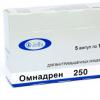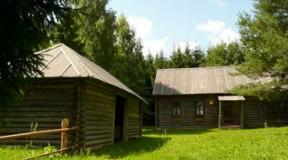Wood chip blocks. Building a house from wood concrete (arbolite blocks) - construction technology, from foundation to roof. For the production of arbolite blocks it is used
Guided by the postulate “if you want it done well, do it yourself,” many people strive to build a house with their own hands. The question arises: from what material? The leaders of the construction market immediately come to mind: concrete, aerated concrete, foam concrete, brick and wood. But there is a material about which one can say “well forgotten old” - this is wood concrete. And the idea of making wood concrete with your own hands is generally great, since it is in no way inferior to the above-mentioned building materials, and in some cases even surpasses them.
What is wood concrete made of, its advantages
Arbolite is a lightweight concrete that has a coarse-grained structure. It is also called wood concrete because wood waste(chips, sawdust, shavings) occupy about 90% of its composition. In addition to wood chips, the composition of wood concrete includes cement (a binding component) and chemical additives. The advantages of this material are obvious:
- It has high strength to bend;
- retains heat well;
- environmentally friendly;
- practically does not burn;
- resistant to low temperatures;
- not susceptible to mold;
- absorbs noise well;
- any building materials adhere perfectly to its surface;
- has low weight;
- its use saves labor costs during installation;
- there is no need to use special equipment;
- when using it there are no problems with the foundation;
- shrinkage of the house does not cause deformation of the walls;
- low cost.
Options for constructing an arbolite structure
Building a house from wood concrete with your own hands is not so difficult. The main thing is to decide on the choice of method for constructing the walls. There are two options:
- the first, using wood concrete blocks, made with your own hands at home or purchased in specialized stores;
- the second, using technology that uses monolithic wood concrete.

That is, the projects are different, but construction material same.
Important! It should be remembered that such material can only be used for low-rise construction (no more than 2-3 floors).
How to make wood concrete blocks on your own
The site for the production of such blocks can be personal plot or garage.
Preparatory stage
First of all, we purchase wood waste from the nearest sawmill ( minimum size wood chips 4.0 x 5.0 x 0.5 cm). A smaller one is not suitable, since when mixed with cement, the relevance of using this component disappears. Next we do this:
- we put wood chips under a canopy and leave it there for 2-3 months;
- treat with lime dissolved in water (2 kg per 120 liters of water);
- periodically mix the waste (2-3 days);
- leave to dry completely;
- mix the wood concrete solution.

Components and proportions of the mixture
To prepare 1 m2 of mixture you will need the following components:
- 300 kg of pre-treated organic filler;
- 300 kg of cement;
- about 400 liters of water;
- 20-30 kg of modified chemical additives.
You can prepare the mixture in a concrete mixer or any suitable container (for example, in a trough).
Preparing the mold for filling
To make the mold we use wooden boards, which we sheathe or sheet metal. We cover the bottom with linoleum. In order to ready product It was easily removed from the mold; we recommend that the design include handles.
Advice! It is recommended to moisten the mold with water before filling it with the solution.

Production of wood concrete blocks
The manufacturing technology is quite simple:
- pour wood chips and modified chemical additives into the container;
- pour in water (not all of it, just enough to cover the waste);
- mix everything well;
- add cement and remaining water;
- mix thoroughly again;
- fill the form with the solution (leave 3-4 cm from the top edge unfilled);
- compact;
- keep the block in the mold for 24 hours;
- remove the block from the mold and leave it under a canopy for 2-3 weeks.

House made of arbolite blocks
The construction of a building such as an arbolite house begins with design and technical documentation.
Design
Documentation for the construction of any private house, which includes not only a building plan, but also information about the foundation, the building materials used, and the possibility of connecting to communications, must be agreed upon and approved by the relevant authorities.
On a note! Designing a structure made of wood concrete is not much different from typical plan building a house from expanded clay concrete.
Foundation construction
Due to the fact that wood concrete has the advantage of being light weight, you can choose absolutely any foundation for your house: on piles, on slabs, strip or columnar. Let's say we are building a house on strip foundation. Work order:
- mark the dimensions of the foundation;
- We sample the soil to the required depth;
- We lay a layer of a mixture of sand and crushed stone on the bottom;
- compact it and spill it with water;
- install reinforcing elements;
- we install wooden formwork;
- pour sand-cement mixture inside the formwork;
- after hardening, lubricate the foundation with bitumen and lay two or three layers of waterproofing (for example, roofing felt);
- the surface limited by the foundation is covered with a mixture of sand and crushed stone and tamped;
- fill with a layer of concrete (more than 50 mm).

Base
We carry out this part of the structure using brickwork 40-50 cm high. The main function of the plinth is to protect wood concrete blocks from the harmful effects of water.
We build walls
The technology for constructing walls from arbolite blocks is similar to the process of constructing walls from some other blocks (aerated concrete, foam concrete, expanded clay concrete) and is very similar to brickwork. We lay out the blocks in a checkerboard pattern, in rows, starting from the corner. We check the degree of vertical deviation using a level. To fasten the blocks we use a cement-sand mixture. After installing three rows, we take a break for 24 hours to allow the bonding solution to dry completely.

Advice! To prevent quick removal moisture from the mixture, we recommend moistening the blocks before laying.
Recommended wall thickness for two-story house– 300 mm, and if higher – 400 mm. The thickness of the walls may be less (for example, 200 mm) if later use is planned heat-insulating materials or external cladding. But remember: it’s warmer where the walls are thicker.
It is not necessary to reinforce walls built with wood concrete. But if you want to increase the strength of corners, junctions of walls, doors and window openings, you can apply reinforcing elements.

Interfloor ceilings
If you have restrictions in cash, then a good option for coverings is wooden beam. If finances allow, then appropriate reinforced concrete slabs or metal channels.
Roofing and rafter installation
Algorithm for installing rafters and installation roofing material for buildings made of wood concrete is the same as for buildings built from other building materials.
Important! Before installing the rafter strapping, it is necessary to lay it on arbolite blocks waterproofing layer.
External and internal finishing
Any materials and methods are used for finishing. Finishing work can be produced immediately after completion of construction or even during the process.

This video will help you how to build a house correctly:
Features of monolithic construction
To build monolithic house, it is necessary to study the installation technology monolithic walls, and other stages of construction are similar to the process of building a house from blocks.
The technology for constructing monolithic walls is very similar to conventional concreting: formwork is also constructed (height - maximum 600 mm), reinforcement is made, wood concrete is poured with a layer of 500 mm (no more). After this, everything is compacted and dries for 3-4 days. Then the formwork is lifted up in order to pour the next layer.
House from monolithic wood concrete in detail - watch the video:
In custody
It becomes clear that building a house from wood concrete with your own hands is not particularly difficult, and knowing all the nuances of making such blocks, you can build a very warm and high-quality house.
In accordance with current legislation, in Russia concrete with organic aggregates can be used in low-rise construction
Material arbolit- lightweight concrete with organic fillers (up to 80-90% of the volume). It was invented by the Dutch around the 30s of the last century. However, in fact, the idea of using organic matter as a filler in concrete - sawdust, wood chips, straw, and so on - has a longer history.
IN Central Asia Traditionally, houses were built from adobe, a mixture of clay and chopped straw. By the way, adobe is still produced in private farmsteads. Bricks were made from a mixture of clay and straw and dried in the sun. They were also popular wall blocks similar in shape to a melon called “guvalya”. They were made from the same material. Such bricks and “blocks” did not have sufficient strength. But in the local climate with scanty precipitation, they served long enough and reliably.
In the USSR, wood concrete became popular in the 60s. GOST was developed, copied from the manufacturing technology of Dutch material under the DURISOL trademark. By this time, wood concrete had already won a place in the markets of Europe and America due to its environmental friendliness, good heat and sound insulating properties and the low specific gravity of the finished product. wall structure. Abroad, this material is called differently: “Durisol” - in Holland and Sweden, “woodstone” - in the USA and Canada, “saw concrete” - in the Czech Republic, “Centeriboad” - in Japan, “Duripanel” - in Germany, “Velox” " - in Austria. It is used in the construction of not only private houses, but also high-rise buildings for industrial purposes.

Types of wood concrete blocks
Composition and tenology of wood concrete very simple - cement, special wood chips, air-perpetuating additive. For industrial production, you need equipment - a chip cutter, a concrete mixer, and molds.
 The Soviet analogue of Durisol passed all technical tests, was standardized and certified. More than a hundred wood concrete factories operated in the USSR. By the way, the material was used for the construction of buildings even in Antarctica. At Molodezhnaya station, three service buildings and a canteen were built from arbolite panels. The thickness of the walls was only 30 cm. There are practically no disadvantages to this material, but there are many advantages. The foundations required for it are the same as for aerated concrete.
The Soviet analogue of Durisol passed all technical tests, was standardized and certified. More than a hundred wood concrete factories operated in the USSR. By the way, the material was used for the construction of buildings even in Antarctica. At Molodezhnaya station, three service buildings and a canteen were built from arbolite panels. The thickness of the walls was only 30 cm. There are practically no disadvantages to this material, but there are many advantages. The foundations required for it are the same as for aerated concrete.
Wood concrete houses quite warm and durable, because such building blocks in accordance with technology. The price of such a house is comparable to the price of a house made of foam-gas concrete. But at their core, these houses are more environmentally friendly.
However, in the Soviet Union, wood concrete did not become a material for mass use. A course was set for the construction of large-scale concrete block houses, for which wood concrete was not suitable due to its characteristics. In the 90s, the wood concrete production industry in Russia fell into decline. But the condition of buildings built from wood concrete 60 years ago shows that the material is quite suitable for use in construction. Moreover, technology does not stand still.


Chip cutter for wood concrete Equipment for wood concrete
 Today, some foreign manufacturers produce wood concrete based on calibrated wood chips coniferous species using special grades of concrete. There is a technology for removing sugars from organic matter, which “encourage” wood to rot, and special methods for drying wood chips. Special additives are used that increase the strength and durability of wood concrete and improve its consumer properties. So the initial advantages of wood concrete - availability of components and environmental friendliness - can be supplemented with new ones. Making high-quality wood concrete with your own hands is difficult, but quite possible. You can buy high-quality wood concrete at a price of 3000 - 3400 rubles/m3.
Today, some foreign manufacturers produce wood concrete based on calibrated wood chips coniferous species using special grades of concrete. There is a technology for removing sugars from organic matter, which “encourage” wood to rot, and special methods for drying wood chips. Special additives are used that increase the strength and durability of wood concrete and improve its consumer properties. So the initial advantages of wood concrete - availability of components and environmental friendliness - can be supplemented with new ones. Making high-quality wood concrete with your own hands is difficult, but quite possible. You can buy high-quality wood concrete at a price of 3000 - 3400 rubles/m3.
In our country, rich in forests, wood concrete can be an excellent material for low-rise individual construction
Arbolite, as a building material, was known back in the days of the USSR, factories were operating and houses were being built. After the collapse of the country, the technology was forgotten for some time, and a few years ago it was remembered again. The material is warm, light, durable, does not conduct sound well, and is also inexpensive. Therefore, wood concrete and wood concrete blocks (arbolite blocks) are increasingly of interest to private developers.
Let’s immediately determine that wood concrete and sawdust concrete are different materials With different characteristics. Wood concrete contains waste from the woodworking industry, but only in a strictly regulated size. There is no other filler anymore. Moreover, everything is prescribed in GOSTs and instructions. And the filler is not sawdust, but wood chips with dimensions recommended by the standard of no more than 40 * 10 * 5 mm.
Properties, advantages and disadvantages
For a private developer, when choosing a building material, it is important specifications material. Let's look at wood concrete blocks from this side. So, the characteristics and their brief explanation:

The properties are very good. Another thing is that they will only be provided that the proportions and technology are strictly observed. This is why arblite blocks are dangerous: you don’t know how well they are made.
Performance characteristics
As you can see, the characteristics of the arboblock are quite good. Another plus is the low weight, big sizes and good ability to absorb sounds. A very big plus is that the blocks are easy to cut and can be easily given the desired shape. Another positive point— wood concrete holds nails and screws well. There are no problems on this side either.
- Shrinkage - 0.5-0.6%. This parameter shows how much the geometric dimensions walls under load. Wood concrete has one of the lowest rates.
- Water absorption 40-85%. This figure is very large. If you put an arbolite block in water, it can absorb a lot of water. For the developer, this means that care must be taken to ensure good waterproofing between the foundation and the first row of blocks. Also arbolite house necessary exterior decoration which will protect the material from moisture. It's not all that scary. It is much more important that the hygroscopicity of wood concrete is low (the ability to accumulate vaporous moisture). Even with very humid air it does not dampen, but allows vapor to pass through itself, regulating the humidity in the room.
- Fire resistance - class G1. Arbolite refers to materials that do not support combustion. This is their undoubted advantage.
If we talk about technical characteristics, then there is essentially one serious disadvantage - high water absorption. There is one more drawback, but it is from the field of operation. Mice love arbolite very much. The material is natural and warm. The problem can be solved by making a high base - no lower than 50 cm.
Technology for the production of wood concrete blocks
Arbolite refers to lightweight concrete, the technology is almost standard, with the exception of some nuances: the need for pressing and the use of a forced concrete mixer when mixing, not an ordinary gravity one. It mixes the wood chips better with the other ingredients.
Compound
The composition of wood concrete includes four components:
- high-quality cement (M 400 or M 500);
- wood chips;
- water;
- chemical additives.

The cement must be dry and fresh. Chips are of a certain size. The less misgrading there is, the stronger the block will be. Chemical additives are calcium nitrate and calcium chloride ( food supplement E509), liquid glass, aluminum sulfate and some other substances. Please note that they are first diluted in water and only then added to the wood chips and mixed. Any drinking water is allowed, but not industrial water, without contamination. After the wood chips are evenly wet, cement is added. Any other sequence is not allowed.
Types and sizes of blocks
Depending on the density, wood concrete blocks are divided into thermal insulation (up to 500 kg/m 3) and structural (from 500 kg/m 3 to 850 kg/m 3). For construction one-story houses you can use the lightest structural ones with a density of 500 kg/m 3. For mansions of 1.5 and 2 floors, the minimum density is 600 kg/m3 and above.
The sizes of arbolite blocks can be different. The most common is 500*200 mm and different thicknesses- from 100 mm to 400-500 mm. But different factories and workshops produce blocks of different sizes. Molds for them can be welded from ordinary sheet iron, so that's not a problem. The photo shows an example of the assortment of one of the workshops.

As you can see, blocks of 600*200 mm and 600*250 mm are also available and thicknesses range from 100 to 500 mm. You can choose suitable ones for load-bearing walls and interior partitions. Also for self-made arbolite blocks can be made into a suitable shape. That is if you decide to make them yourself.
Proportions
Like any building material, wood concrete is divided into strength classes. For the construction of load-bearing walls of houses required class strength B 2.5.

The amount of necessary materials per cubic meter of wood concrete mortar is in the table (photo above).

Pressing technologies
All these components are mixed and blocks are formed from them. There are several technologies:
- just by pressing:
- manual on the floor (great effort required);
- manual rammer on a vibrating table.
- pressing with vibration on a vibrating machine.
The easiest way to do this is by hand pressing. But it is difficult to control the density and strength of the resulting blocks in this way.

Normal production conditions
For the normal process of cement hydration, a temperature of at least +12°C is required. There are no other conditions. The peculiarity of production is that after molding the block, at least 2-3 weeks must pass before it can be used. During this time, the cement will gain about 50-60% strength (depending on temperature) and you can already work with the blocks. That is, blocks must be made long before construction begins. If you consider that wood chips must be left in storage for at least 4 months before being used, then you can start a year before construction.

Another practical point: if you are going to make wood concrete blocks with your own hands, in addition to a platform for mixing and storing components, you need a platform for settling the blocks. The place should be covered, protected from rain and sun. There should be no drafts either.
Wood chips: how to get or where to buy
The best wood chips for wood concrete are made from pine and spruce. You can also use larch, but when mixing it is necessary to double the amount of chemical additives. Among hardwoods, GOST allows the use of aspen, beech, birch, and poplar. The remaining requirements are:

The best wood chips come from lump waste wood. It is first passed through chippers and then crushed in a hammer crusher. The following mechanisms can be used for this:
- Disc chippers with adjustable knives. Not all of them can be adjusted to produce chips of the required size, but the sizes will be close.
- Rotary knife crushers. They produce narrow and not wide chips, and the length is adjustable. That is, this is - a good option. There is only one “but”: there are a lot of knives and with prolonged use they need to be changed or welded (they do not sharpen). As an advantage, we add that crushers of this type can be used for re-crushing process chips obtained during the first crushing (after reconfiguration).
- Shredders or roller grinders. This expensive equipment(about 1 million rubles), mostly imported, but it is excellent because it is made for certain sizes of wood chips.
If you do arbolite chips Doing it yourself is not an option; you can buy it. If possible, you can negotiate at the factory where wood concrete is produced. Just check the chip parameters. If there is none nearby, you can take shavings from under the calibration machines. Some of them can be adjusted so that the chips are not thick.
Features of making mortar for arbolite blocks
Wood waste contains sugars. If you use fresh raw materials, the sugars may begin to ferment, which will cause the destruction of the integrity of the block. When mixing, chemical additives are added to the solution that neutralize their effects (liquid glass, calcium chloride, alumina sulfate, lime). They can be added in combinations: calcium chloride with liquid glass or alumina sulfate with lime. The total mass of additives should not exceed 8%.
There are other ways to break down sugars. The simplest, but requiring a long period of time, is to keep the wood chips in a pile for at least 90 days in the air. If it is not possible to wait, the wood chips are soaked for 3 days in lime milk, stirring occasionally. Then it is strained, not dried, and used in this form for kneading. Only in this case it is necessary to take into account that significantly less water will be required. This method works well, but it is very troublesome. It is easier to find an opportunity to purchase chemical additives.
The procedure and features of mixing the solution
A concrete mixer is used to mix the solution. forced type. You can also use a regular gravity or “pear”, but you have to knead in it for a long time, although you can adapt - tilt the pear as low as possible when kneading (it hardly mixes when raised).

First, sawdust is poured in and a certain amount of water is added. While the sawdust is getting wet, chemical additives are diluted in a small amount of water, then they are unloaded into a concrete mixer. When all the wood is uniformly wet, cement is poured. It is loaded in portions, waiting for uniform distribution throughout the entire volume. The cement should envelop each chip from all sides. This is only possible if the sawdust is well wet, so we monitor this stage carefully.
Block molding
The solution is poured into molds. Most often they are made of metal and are a box with handles without a bottom. The form is placed on a flat surface (a board, for example). When manually tamping, the molds are filled with wood concrete mortar, layer by layer, each of which is pressed with a metal platform with a handle. In order for the air to escape better, the thickness of the material is pierced several times. metal rod, after which they are pressed again. This procedure can be repeated several times until the desired layer density is reached, after which the next one can be poured. The layers are poured to the upper edge of the block, after final compaction the top is leveled, cutting off the excess with a metal strip.
You can use a lever - mechanical or driven. In this case, the force develops significant and the entire volume can be loaded at once, if necessary, adding to the edge. To achieve high density, you can press several times, now increasing and then weakening the pressure. Experience shows that with this principle of manufacturing arbolite blocks, they are more durable, and depressing (restoring shape due to the elastic force of the chips) is much less pronounced.
Better blocks in terms of strength and with less effort are obtained if vibration is added during the pressing process. In this case, the efforts required to obtain the required strength are reduced significantly. Vibrating tables are made for these purposes. And the process is called vibration with a weight.
The formed block on a stand is transferred to the drying place. If the solution allows and the block holds its shape, the frame can be removed. But sometimes homemade wood concrete blocks suffer from the fact that the solution turns out to be too liquid - it’s easier to compact it this way. In this case, the blocks are left in the mold for a day. Use and transportation of blocks is possible no earlier than 2-3 weeks after molding.
Features of the construction of their arbolite blocks
The masonry of blocks is carried out according to the brick type - with ligation of seams, on cement-sand mortar. One of the features is the thickness of the seam - about 8-10 mm. Between the foundation and the first row of blocks it is necessary to make a very high-quality cut-off waterproofing. This will prevent moisture from leaking through the foundation from the soil. We do a combination of waterproofing - first we impregnate bitumen mastic or any other coating waterproofing, we lay it on top roll waterproofing. In the past, roofing felt was always used, but today it is of low quality and will collapse in a couple of years. And it is important to prevent moisture leakage (due to the high water absorption of wood concrete), so use waterproofing or something similar. It is possible, in two layers, also coated with bitumen mastic.
The next nuance is the masonry above the window and doorways. It is best to use special U-shaped blocks in which to lay a reinforcing frame and 4 reinforcement bars with a diameter of 10-12 mm. It is better to tie it down so that there is less chance of corrosion. First, blocks with recesses are installed above the opening. They can be supported from below with a board and spacers. Then the frame is laid, everything is filled with concrete. Leave the structure for a day, after which the supports can be removed and masonry can continue.

There are many nuances of building a house from wood concrete blocks in the video.
Blocks made of cement and sawdust
When producing products for construction, cement and wood chips are mixed. The technology is accessible and does not require the use of special equipment. Independent production using sawdust blocks allows you to significantly reduce the estimated cost of construction and prepare a material with your own hands that is environmentally friendly. The increased performance characteristics of products made from Portland cement and sawdust make it possible to construct residential buildings, cottages, as well as outbuildings. For correct application of the material, it is necessary to study the characteristics, recipe, become familiar with the advantages and disadvantages, and also master the technology for manufacturing products from cement and wood waste.
Sawdust concrete blocks - characteristics
Sawdust blocks are a lightweight building material. They are a type concrete products, characterized by a reduced specific gravity. Thanks to unique properties, the material is in demand in the construction industry.

Wood concrete is a lightweight type of concrete based on sawdust and high-quality cement
Differs in the following characteristics:
- thermal properties. In buildings based on sawdust concrete blocks, it is easy to maintain a comfortable temperature regime;
- environmental safety. Sawdust blocks are made from raw materials of natural origin;
- increased safety margin. Sawdust concrete blocks ensure the stability of the buildings being erected;
- fire safety. The manufacturing technology and the components used ensure the fire resistance of the concrete composite;
- increased vapor permeability. The structure of the array helps maintain favorable room humidity;
- resistance to temperature fluctuations. Blocks made from shavings and cement can withstand repeated cycles of freezing followed by thawing;
- affordable price level. By using building blocks based on cement and wood chips, you can significantly reduce the estimated cost of construction.
Depending on the specific gravity sawdust blocks are divided into the following types:
- thermal insulation, characterized by a density of 0.4–0.8 t/m3;
- structural, the specific gravity of which is 0.8–1.2 t/m3.
High technical characteristics ensure the popularity of products made on the basis of cement binder and sawdust.

Sawdust concrete belongs to the category of lightweight materials
Blocks made of sawdust and cement - advantages and disadvantages
Sawdust blocks have the following advantages:
- increased degree of sound insulation. The sawdust concrete composite absorbs extraneous noise, which makes you feel comfortable in the room;
- harmlessness to others. When using products made from environmentally friendly natural raw materials, no harmful substances are released;
- fire resistance. Blocks of sawdust and cement do not ignite when exposed to temperatures up to 1100 °C for two and a half hours;
- ease of processing. The material is quickly processed by the tool and maintains its integrity under mechanical stress;
- accessibility. Chips are a waste product from wood processing enterprises and are available at an affordable price;
- simplicity of masonry. Building blocks, characterized by increased volume and low weight, allow you to quickly erect walls;
- long service life. Products made with high quality and protected from moisture absorption are durable.

Blocks made from these materials are widely used in the construction of houses, cottages, outbuildings
Along with the advantages, the material also has weaknesses:
- Long production cycle. Acquisition performance characteristics occurs within three months from the moment of pouring into molds.
- Increased moisture absorption. Sawdust concrete needs reliable moisture protection from all sides.
- Possibility of using wood chips only from certain types of wood. Sawdust with a reduced sugar content is used, the decomposition process of which affects the strength of the material.
Having assessed the advantages and analyzed the disadvantages, many developers prefer products based on cement and wood chips.
Making blocks from sawdust and cement with your own hands
The production of sawdust blocks involves the following steps:
- Procurement of raw materials for the manufacture of sawdust concrete products. The presence of the necessary materials in construction warehouses allows you to purchase all components before starting production.
- Preparation the necessary tool or mixing equipment. You can use a concrete mixer to prepare the mixture in larger volumes or manually mix it in a container using shovels.

The undoubted advantage of sawdust concrete is that you can make it yourself
- Mixing components in accordance with the recipe. The use of concrete mixers for automation helps to improve the quality of mixing, productivity, and improves the quality of sawdust concrete.
- Pouring the solution into molds. Collapsible wooden containers are used, made from 20 mm thick boards, lined plastic sheets or metal.
- Drying sawdust concrete under natural conditions. Acquisition of operational hardness and evaporation of moisture occurs within 90 days after molding of sawdust concrete products.
Block composition
Sawdust blocks are made based on the following ingredients:
- Portland cement;
- sand;
- clay or slaked lime;
- wood chips;
- water.
Components
Waste is used for production various types wood:
- pine trees;
- fir;

To make wood concrete, you need clean wood chips (wood particles), not bark or leaves.
- poplars;
- ash;
- birch;
- beech;
- oak;
- hornbeam;
- larches.
Sawdust concrete and wood concrete blocks are a lightweight building material with good thermal insulation characteristics. They are used for the construction of private houses, outbuildings and fences. Sawdust concrete and wood concrete can be purchased ready-made or made with your own hands. For manufacturing, you will need the same components as for standard concrete blocks, but with the addition of sawdust or wood chips. They can be both structural and thermal insulating.
For sawdust concrete blocks you will need cement, sawdust, sand, quicklime and water. Portland cement is taken at a grade no lower than M300. It is better to use sawdust from coniferous trees, as they are less susceptible to rotting. If they are old or obtained from other wood, then they need to be prepared. Treat with antiseptic agents, for example, calcium chloride solution, and dry.
The density of sawdust and cement blocks depends on the proportions of the components. The more Portland cement, the stronger material, but so much the worse thermal insulation properties. At the same time, resistance to low temperatures and moisture increases and the likelihood of corrosion in reinforced blocks decreases.
If you add more sawdust, the wood concrete blocks will retain heat better, but it will not be used for construction load-bearing structures it is forbidden. Due to the small amount of cement in the composition, it will have weak strength. Therefore, it can only be used as thermal insulation of a finished structure. At the same time, the masonry does not require the construction of an additional foundation, since it is light in weight.
Blocks made from a mixture of cement and sawdust are used for the construction of load-bearing and interior walls buildings, enclosing structures, for the reconstruction of already rebuilt structures, as well as for insulation of houses and basements.
Positive and negative characteristics
Advantages of block material made from sawdust (they are confirmed by numerous reviews given in the material about):
- easy to process - sawdust concrete can be cut with a regular hacksaw and drilled, just like aerated concrete or foam concrete;
- has good adhesion characteristics – during processing adhesive compositions the finishing coating is securely attached to it;
- good thermal insulation properties;
- low flammable - with the right technology manufactured sawdust concrete can withstand direct exposure to fire for about three hours (if the amount of sawdust does not exceed 50% of the total volume);
- environmentally friendly;
- soundproofs;
- simple masonry;
- long service life.

Sawdust concrete acquires the property of fire resistance as a result of enveloping sawdust cement-sand mixture. Compared to concrete with polystyrene foam granules, blocks made from sawdust are more fireproof.
The disadvantages include long time strength gain. After production, the 20 cm thick building blocks are left for 3 months to completely harden. Only after this period can you begin laying them. Sawdust concrete has poor resistance to water. Therefore, after the construction of the house, a vapor barrier should be installed to protect it both from the inside and outside of the building.

How to do it yourself?
There are many technologies for making blocks from sawdust. Not only cement, but also gypsum or clay can be selected as a binder component. But if the block material will be used for the construction of loaded structures (walls), then Portland cement is used. To prepare the solution yourself, it is recommended to use a concrete mixer, since a completely homogeneous consistency is required.
According to the technology established in accordance with GOST, in order to make high-quality blocks, you will need to mix the components in the following proportions - 1 part cement, 1 sawdust, 3 sand and 50% of the volume of binder water. Calcium chloride is taken 40 times less than the amount of cement powder. That is, for 20 kg of Portland cement M400 you will need 20 kg of sawdust, 59-60 kg of sand and 10 liters of water. Additionally, 0.5 kg of calcium chloride is added. In percentage terms, sawdust should account for almost 55% of the volume of the entire solution, sand - 26%, cement - about 12%, water - 7%.
Sand is used in medium or coarse fraction. In this case, about 10% fine fraction is added. Only clean water is poured. It is best to use drinking water or rain water, the main thing is that it is free of impurities and dirt.

To make the blocks yourself, you will need molds into which the mixture will be placed. It is recommended to make them collapsible to make it easier to remove the finished material. It can be built from boards 20 mm thick. They are covered inside with sheets of steel so that moisture from the solution is not absorbed into wooden case. In addition, thanks to the metal, the block material can be easily separated from the mold.
When assembling a box for sawdust concrete or wood concrete blocks, you should take into account that after drying they decrease in size. Therefore, the mold must be made 10% larger than the required size of the material. If there are blocks with voids, for example, round ones, then roofing felt, rolled into a tube, is placed in the box in advance.
Manufacturing technology: sawdust is sifted through a sieve and mixed with Portland cement and sand. Water is gradually poured in. To check the quality, the solution is squeezed in a fist. It should be crumpled into a lump, no water should leak out. If drops are visible, it means it was mixed incorrectly. After preparation, the composition must be dissolved within one and a half hours. The mixture is placed in a mold. Every 20 cm it is compacted to compact and remove air. After filling, everything is left for 4 days. After which it can be disassembled and the block building material can be stored in a dry and ventilated area for further hardening.

Peculiarities
For arbolite blocks, not sawdust with sand is used, but only wood chips; cement and various additives are also needed that improve other characteristics. Compared to sawdust concrete, this material has even better thermal insulation properties. It is also lightweight, frost-resistant and non-flammable. The blocks are environmentally friendly, they are easy to cut and process.
To make these blocks yourself, you will need molds. The solution is mixed in a concrete mixer. To make wood concrete blocks, the components are mixed in the following proportions: 3 parts cement, 3 parts wood chips and 4 parts water. First, wood chips are poured into the concrete mixer and water is poured in (not all at once, only until it becomes semi-liquid). Liquid glass is added (1% of the total volume). After the consistency has become homogeneous, Portland cement M400 is poured in and the remaining water is poured in.
Once the solution is thoroughly mixed, it is placed in a mold for wood concrete blocks. The mixture is tamped every 15-20 cm. After a day, if the material has hardened, it is removed from the molds and left to gain strength. After 2-3 weeks the blocks can be used.
Read also...
- Step-by-step instructions for opening a certificate of incapacity for work - how to take sick leave correctly?
- Anton Shoki about life after the project: “I found a job in a hotel
- Biography of Nadezhda Sokolovskaya from House 2
- Why do babies in medieval paintings look like terrible men and how they became beautiful during the Renaissance Things sticking out of their butts



















